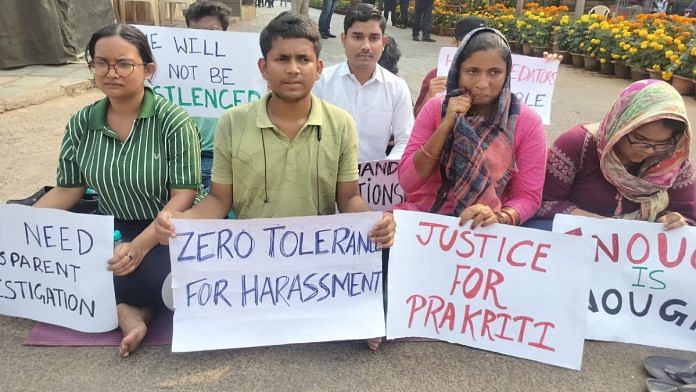Bhubaneswar: A sit-in protest by students and activists of Left-leaning students’ outfits continues at the gates of the Kalinga Institute of Industrial Technology (KIIT) here, even as the administration insists that it is business as usual. Protesters accuse the administration of launching a campaign to identify those who took active part in protests held on campus on 17 and 18 February following the death of a 20-year-old student from Nepal.
“Wardens are approaching us in Kings Palace and Queens Palace hostels to identify who all participated in the protests last night. We’re scared for our careers,” says a third-year computer science student who didn’t wish to be named. Some students also received emails, seen by ThePrint, from companies cancelling offer letters extended to them citing ‘recent instability’ on campus. The offers were, however, later reinstated.
On 16 February, Prakriti Lamsa, a third-year BTech student at KIIT, died allegedly by suicide. Lamsa’s batchmates say she was being harassed allegedly by her boyfriend Advik Srivastava since October 2024 when she first tried to end their relationship.
Srivastava, 21, was arrested Monday in connection with her death.
“The student (Lamsa) repeatedly sent complaints to the international grievance cell but he (Srivastava) was let off after warnings by the administration. The matter escalated so much because there’s no proper internal complaints committee at the university,” Sanghamitra, president of Odisha unit of All India Student Federation (AISF), tells ThePrint.

But Dr Shradhanjali Nayak, director of KIIT’s public relations wing, maintains Lamsa sent a complaint to the international grievance cell last month, and Srivastava was suspended on the spot. The university was not aware of any further correspondence between the two, says Nayak. The administration, however, could not produce a copy of the suspension.
Nayak also says that nearly 100 of the more than 500 Nepalese students evicted by the university in light of protests following Lamsa’s death never left the campus, and another 50 have now returned. Others have gone back to Nepal or remain stuck in Patna, Siliguri or Kolkata, according to fellow students.
A second-year BTech student from Nepal says he was sleeping in his hostel, when university staffers and policemen entered his room and woke him up forcibly Monday morning. “They entered my room and beat me. Forced us to evict the university.”
The student adds that he gathered his belongings, followed the policemen into a bus and was dropped off at Bhubaneswar railway station. “I took a train to Kolkata and from there came to my relatives in Bihar. I am very scared of coming back to that place. I am in India but very, very far from the university.” Asked about these claims, Nayak tells ThePrint, “We evicted the students because that’s what we thought was the right thing to do at that point. Things were getting out of control, but nobody forcefully removed the students.”
Also Read: Rohtak med student influencer posted everything—including how a senior stalked, abducted her
No cohesive voice
AISF activists staging the sit-in protest are joined by activists of the Students’ Federation of India (SFI). In the absence of a union of their own, students find it hard to raise their voices as a cohesive unit. “Who asked you to involve outside elements in our protest,” one student charges at the other. “You’re a stooge of the university,” retorts a protester.
A computer science student says they had nothing to do with the vandalism that occurred on campus on the evening of 18 February. “We were all out on a candle march, and some elements vandalised university property behind us. We had nothing to do with it.” The claim was reiterated by others. While the administration maintains it is business as usual, a student of aerospace engineering alleges, “We are being forced to come to class. If we don’t come to class, teachers are threatening us that our careers will end.”

Protesters are demanding that the state take over the administration of KIIT and constitute a students’ body. They also want President Droupadi Murmu to visit the campus.
Meanwhile, the controversy over Lamsa’s death spilled over to the Nepalese parliament after a video surfaced of a KIIT faculty member telling protesting students that the annual budget of Nepal was lower than the amount spent by the university’s founder on the education of underprivileged kids. On this issue, Nayak says, “I don’t know why these teachers made such a statement. We condemn them and apologise for them. They should’ve at least been aware of the cameras around them.”
A deemed-to-be-university, KIIT has over 40,000 students, of which 1,500 are international students. A majority of these students are from Nepal, Bangladesh and African nations.
(Edited by Amrtansh Arora)
Also Read: Gargi College students allege harassment by ‘drunk’ outsiders at fest, call strike







Odisha’s population suffers from xenophobia. The average Odia is very insecure of “outsiders” and discriminates against them.
I, being an Indian, faced so much racism and discrimination in Odisha. I can only wonder about the treatment meted out to foreign citizens.
What’s even more shameful is that the KIIT authorities, in connivance with Odisha government officials, are trying their level best to suppress the issue and portraying themselves as innocent.